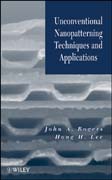
Patterning or lithography is at the core of modern science and technology andcuts across all disciplines. With the emergence of nanotechnology, conventional methods based on electron beam lithography and extreme ultraviolet photolithography have become prohibitively expensive. As a result, a number of simple and unconventional methods have been introduced, beginning first with researchdemonstrations in the mid 1990s. This book focuses on these unconventional patterning techniques and their applications to optics, organic devices, electronic devices, biological devices, and fluidics. INDICE: PART I: NANOPATTERNING TECHNIQUES. Chapter 1: Introduction. Chapter 2: Materials. 2.1 Introduction. 2.2 Mold Materials and Mold Preparation. 2.3Surface Treatment and Modification. References. Chapter 3: Patterning Based on Natural Force. 3.1 Introduction. 3.2 Capillary Force. 3.3 London Force and Liquid Filament Stability. 3.4 Mechanical Stress: Patterning of Metal Surface. References. Chapter 4: Patterning Based on Work of Adhesion. 4.1 Introduction.4.2 Work of Adhesion. 4.3 Kinetic Effects. 4.4 Transfer Patterning. 4.5 Subtractive Transfer Patterning. 4.6 Transfer Printing. References. Chapter 5: Patterning Based on Light: Optical Soft Lithography. 5.1 Introduction. 5.2 System Elements. 5.4 3D Optical Soft Lithography. 5.5 Applications. References. Chapter 6: Patterning Based on External Force: Nanoimprint Lithography. 6.1 Introduction. 6.2 NIL Mold. 6.3 NIL Resist. 6.4 The Nanoimprint Process. 6.5 Variations of NIL Processes. References. Chapter 7: Patterning Based on Edge Effects: Edge Lithography. 7.1 Introduction. 7.2 Topography-Directed Pattern Transfer. 7.3 Exposure of Nanoscale Edges. References. Chapter 8: Patterning with Electrolytes. 8.1 Introduction. 8.2 Solid-State Superionic Stamping (S4). 8.3 Process Technology. 8.4 Process Capabilities. 8.5 Examples of Electrochemically Imprinted Nanostructures Using the S4 Process. References. Chapter 9: Patterning with Gels: Lattice-Gas Models. 9.1 Introduction. 9.2 The RDF Method. 9.3 Microlenses : Fabrication. 9.4 Microlenses : Modeling Aspects. 9.5 FRD at the Nanoscale. References. Chapter 10: Patterning with Block Copolymers. 10.1 Introduction. 10.2 Orientation. 10.3 Long Lange Order. 10.4 Nanoporous BCP Films. References. Chapter 11: Perspective on Applications. PART II: APPLICATIONS. Chapter 12: Soft Lithography for Microfluidic Microelectromechanical Systems (MEMS) and Optical Devices. 12.1 Introduction. 12.2 Microfluidic Device for Concentration Gradients. 12.3 Electrochemistry and Microfluidics. 12.4 PDMS and Electrochemistry. 12.5 Optics and Microfluidics. 12.6 Unconventional Soft Lithographic Fabrication of Optical Sensors. References. Chapter 13: Unconventional Patterning Methods for Biomems. 13.1 Introduction. 13.2 Fabrication of Nanofluidic System for Biological Applications. 13.3 Fabrication of Biomolecular Nanoarrays for Biological Applications. 13.4 Fabrication of Nanoscale Topographies for Tissue Engineering Applications. References. Chapter 14: Micro Total Analysis System. 14.1 Introduction. 14.2 Fundamentals on Microchip Chemistry. 14.3 Key Technologies. 14.4 Applications. References. Chapter 15: Combinations of Top-Down and Bottom-Up Nanofabrication Techniques and Their Application to Create Functional Devices. 15.1 Introduction. 15.2 Top-Down and Bottom-Up Techniques. 15.3 Combining Top-Down and Bottom-Up Techniques for High Resolution Patterning.15.4 Application of Combined Top-Down and Bottom-Up Nanofabrication for Creating Functional Devices. References. Chapter 16: Organic Electronic Devices. 16.1 Introduction. 16.2 Organic Light Emitting Diodes. 16.3 Organic Thin Film Transistors. References. Chapter 17: Inorganic Electronic Devices. 17.1 Introduction. 17.2 Inorganic Semiconductor Materials for Flexible Electronics. 17.3 Soft Lithography Approach to Generate Inorganic Electronic Systems. 17.4 Fabrication of Electronic Devices. References. Chapter 18: Mechanics of Stretchable Silicon Films on Elastomeric Substrates. 18.1 Introduction. 18.2 Buckling Analysis of Stiff Thin Ribbons on Compliant Substrates. 18.3 Finite-Deformation Buckling Analysis of Stiff Thin Ribbons on Compliant Substrates. 18.4 Edge Effect. 18.5 Effect of Ribbon Width and Spacing. 18.6 Buckling Analysis of Stiff Thin Membranes on Compliant Substrates. 18.7 Precisely Controlled Buckling of Stiff Thin Ribbons on Compliant Substrates. References. Chapter 19: Multiscale Fabrication of Plasmanic Structures. 19.1 Introduction. 19.2 Soft Lithography and Metal Nanostructures. 19.3 A Platform for Multi-Scale Patterning. 19.4 Subwavelength Arrays of Nanoholes : Plasmonic Materials. 19.5 Microscale Arrays of Nanoscale Holes. 19.6 Plasmonic Particle Arrays. References. Chapter 20: A Rigiflex Mold And Its Applications. 20.1 Introduction. 20.2 Modulus-Tunable Rigiflex Mold. 20.3 Applications of Rigiflex Mold. References. Chapter 21: Nanoimprint Technology for Future Liquid Crystal Display. 21.1 Introduction. 21.2 Holographic Light Guide Plate. 21.3 Polarized Light Guide Plate. 21.4 Reflective Polarizer: Wire Grid Polarizer. 21.5 Transflective Display. References.
- ISBN: 978-0-470-09957-5
- Editorial: John Wiley & Sons
- Encuadernacion: Cartoné
- Páginas: 620
- Fecha Publicación: 28/11/2008
- Nº Volúmenes: 1
- Idioma: Inglés
